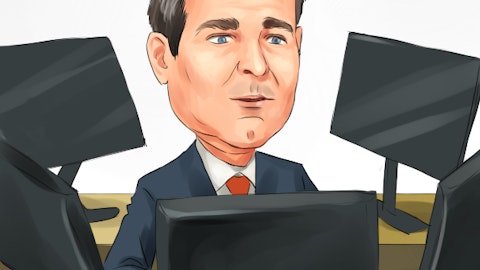Beyond enabling reasonable flexibility in our capital structure, we are also focused on minimizing dilution and reducing our organic stock-based compensation expense as a percent of revenue, by at least 300 basis points over the next three years. Lastly, we will use share buybacks opportunistically, something that you have seen from us over the last five years, as we have repurchased nearly $4 billion cumulatively. In concluding my section on bringing it altogether, I wanted to bring together the financial targets I’ve covered. As Nikesh mentioned at the outset, we’re focused on an evergreen innovation led approach that will continue to fuel our transformation into a software, and AI driven cybersecurity company. I am more excited than ever about our growth prospects over the next several years and our plans to continue to do this profitably, benefiting from our platform business model.
I hope my excitement comes through today, and you can clearly see that drives our confidence in these targets from the various presentation. With that, we’ll now transition to taking your questions. And I will hand the call back to Walter to manage this. Walter?
Walter Pritchard: We’ll now take questions on the entire program. We’re going to start first with Hamza Fodderwala from Morgan Stanley and go next to Andrew Nowinski from Wells Fargo. Hamza, please go ahead.
Unidentified Analyst: Hi. Apologies. Can you guys hear me? Hi [indiscernible] dialing in for Hamza. Thank you guys so much for taking my question today and really congrats on the great quarter. You did mention that, you know, AI is a very large opportunity for the company going forward. And I know that you broke down, some of the gross margins as well as, potential operating margins impact, but could you just, let us know how we should think about the company’s investment for AI going forward? Are there any upfront CapEx, or margin that that we should consider a little bit more. Thank you so much.
Nikesh Arora: Hi. Yes. Thank you very much for your question. Like, it’s early days in AI, as I mentioned on the precision AI side, we have been using it. We have been using it across our products. There’s no incremental costs. So it’s embedded in our current product development capabilities. On the generative AI side, I say you saw a sneak peek of all the copilots. The good news is all of those things, should generate positive outcomes for us either in terms of incremental modules that customers would like to buy, to enable certain functionality, or possibly reduce costs from our capabilities, to deliver much superior customer support. So, I think at this point in time, I would not in baking any incremental sort of spend expectations in our forecast, as it relates to the implementation of AI.
Dipak has given you guidance that we can continue to see operating leverage, and operating margin, clearly some of that is driven by expectations in AI, but I’d say we’re being normal about it. We’re not overtly aggressive nor are we overtly conservative around it. And hopefully, there’ll be upside in that, if and when we start to see the fruits of deploying it effectively across Palo Alto Networks.
Walter Pritchard: Thank you. Next we’re going go to Andrew Nowinski from Wells Fargo with Brian Essex from JPMorgan after that. Go ahead, Andrew.
Andrew Nowinski: Thanks, Walter. And congrats on a nice quarter as well. So I wanted to ask about Zero Trust that’s clearly a top priority – and really, it seems like it’s the only architecture that’s capable of stopping a sophisticated attack. And you showed how it requires hardware, software, and SASE components. So, if we think about Zero Trust demand continuing to ramp going forward, why would, firewall demand drop? I think you said the 10% of total revenue in fiscal ’26, if it’s such a critical component of the of your Zero Trust offering?
Nikesh Arora: It’s important to understand. We didn’t say it will drop 10% of revenue. Everything else is growing really fast. I think it’s important to understand, like, it’s not growing as fast as everything else. Look, for the last five years, I’ve always been asked that hardware question. I’ve been trying to avoid it for five years unsuccessfully. So thanks again, Andrew, only took one question to get to it. I think it’s important to understand, as we started moving to the cloud, people started coming to notion of software firewalls. And then with this whole pandemic thing, remote work, and sort of distributed network became a real thing. So what you’re seeing is, that there are different form factors, which are really good in different circumstances.
Against the public cloud, you put a software firewall, you use VMs in various scenarios, when throughput becomes really important hardware is still the best option. And I don’t think the whole world is going to end up only in the public cloud. By the way, we also sell firewalls to the cloud provider believe it or not, they need firewalls in their data centers, because eventually the public cloud also runs in our data center. So, I think in that context, the demand for hardware is not going to go away. I think what Anand showed you beautifully that you’re going to end up with all the form factors at most of our customers. And the key is these things need to work better together. I think if you go today, there are many customers who have a Palo Alto firewall and a firewall from another vendor.
Now if we can give them SASE, we can give them software firewalls. There is no reason that they should be on two hardware vendors when they are a single software vendor, and a single SASE vendor. So, I think the point we want to highlight here is, there is a further consolidation opportunity in the firewall space driven by the Zero Trust needs as well as the UI that Anand gave you a sneak peek into. So, I think that’s the way to think about it. We like hardware. It’s great.
Andrew Nowinski: Thanks.
Walter Pritchard: Great. Thanks, Andy. Next question is from Brian Essex at JPMorgan followed by – Jonathan Ho at William Blair. Go ahead, Brian.
Brian Essex: Great. Thank you, Walter. And thanks for taking the question. And Nikesh, thank you for making this a better Friday night than some of those conspiracy theories floating around implied?
Nikesh Arora: We have 5,500 dialed in, Brian. That makes up, like, the last six earnings calls we’ve had. So I don’t know maybe there’s bear here.




